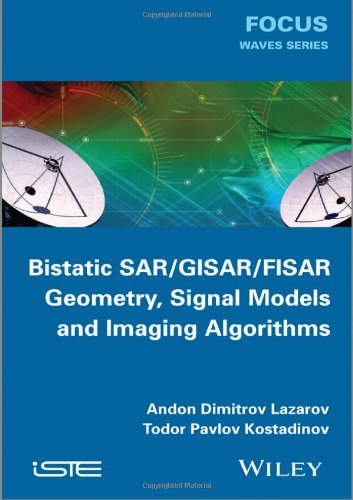Bistatic SAR ISAR FSR Theory Algorithms and Program Implementation 1st Edition by Andon Dimitrov Lazarov, Todor Pavlov Kostadinov 1848215746 9781848215740
$50.00 Original price was: $50.00.$35.00Current price is: $35.00.
Bistatic SAR ISAR FSR Theory Algorithms and Program Implementation 1st Edition by Andon Dimitrov Lazarov, Todor Pavlov Kostadinov – Ebook PDF Instant Download/Delivery: 1848215746, 9781848215740
Full download Bistatic SAR ISAR FSR Theory Algorithms and Program Implementation 1st Edition after payment

Product details:
ISBN 10: 1848215746
ISBN 13: 9781848215740
Author: Andon Dimitrov Lazarov; Todor Pavlov Kostadinov
Bistatic radar consists of a radar system which comprises a transmitter and receiver which are separated by a distance comparable to the expected target distance. This book provides a general theoretical description of such bistatic technology in the context of synthetic aperture, inverse synthetic aperture and forward scattering radars from the point of view of analytical geometrical and signal formation as well as processing theory. Signal formation and image reconstruction algorithms are developed with the application of high informative linear frequency and phase code modulating techniques, and numerical experiments that confirm theoretical models are carried out. The authors suggest the program implementation of developed algorithms. A theoretical summary of the latest results in the field of bistatic radars is provided, before applying an analytical geometrical description of scenarios of bistatic synthetic aperture, inverse synthetic aperture and forward scattering radars with cooperative and non-cooperative transmitters. Signal models with linear frequency and phase code modulation are developed, and special phase modulations with C/A (coarse acquisition) and P (precision) of GPS satellite transmitters are considered. The authors suggest Matlab implementations of all geometrical models and signal formation and processing algorithms. Contents 1. Bistatic Synthetic Aperture Radar (BSAR) Survey. 2. BSAR Geometry. 3. BSAR Waveforms and Signal Models. 4. BSAR Image Reconstruction Algorithms. 5. Analytical Geometrical Determination of BSAR Resolution. 6. BSAR Experimental Results. 7. BSAR Matlab Implementation. A general theoretical description of bistatic technology within the scope of synthetic aperture, inverse synthetic aperture and forward scattering radars from the point of view of analytical geometrical and signal formation and processing theory. Signal formation and image reconstruction algorithms are developed in this title, with application of high informative linear frequency and phase code modulating techniques. Numerical experiments that confirm theoretical models are carried out and the authors suggest program implementation for the algorithms developed.
Bistatic SAR ISAR FSR Theory Algorithms and Program Implementation 1st Table of contents:
CHAPTER 1. BISTATIC SYNTHETIC APERTURE RADAR (BSAR) SURVEY
1.1. Introduction and main definitions
1.2. Passive space-surface bistatic and multistatic SAR
1.3. Forward scattering radars
1.4. A moving target problem as an inversion problem in multistatic SAR
1.5. BSAR models, imaging, methods and algorithms
1.5.1. Range migration algorithm for invariant and variant flying geometry
1.5.2. Bistatic point target reference spectrum based on Loffeld’s bistatic formula
1.5.3. Target parameters extraction
CHAPTER 2. BSAR GEOMETRY
2.1. BGISAR geometry and kinematics
2.2. Multistatic BSAR geometry and kinematics
2.3. BFISAR geometry and kinematics
2.3.1. Kinematic parameter estimation
CHAPTER 3. BSAR WAVEFORMS AND SIGNAL MODELS
3.1. Short pulse waveform and the BSAR signal model
3.1.1. Short pulse waveform
3.1.2. Short pulse BSAR signal model
3.1.3. Target’s parameters estimation in short range BFISAR scenario
3.2. LFM pulse waveform
3.2.1. LFM BSAR signal model
3.3. CW LFM waveform and modeling of deterministic components of BSAR signal
3.4. Phase code modulated pulse waveforms
3.4.1. Barker phase code
3.4.2. Complementary code synthesis
3.4.3. BSAR-transmitted complementary phase code modulated waveforms
3.4.4. GPS C/A phase code
3.4.5. GPS P phase code
3.4.6. DVB-T waveform
CHAPTER 4. BSAR IMAGE RECONSTRUCTION ALGORITHMS
4.1. Image reconstruction from a short pulse BSAR signal
4.2. LFM BSAR image reconstruction algorithm
4.3. PCM BSAR image reconstruction algorithm
4.4. Autofocus algorithm with entropy minimization
4.5. Experiment with the multistatic SAR LFM image reconstruction algorithm
CHAPTER 5. ANALYTICAL GEOMETRICAL DETERMINATION OF BSAR RESOLUTION
5.1. Generalized BSAR range and Doppler resolution
5.1.1. BSAR range resolution
5.1.2. BSAR Doppler resolution
5.2. Along-track range resolution
5.3. Range resolution along a target–receiver line of sight
CHAPTER 6. BSAR EXPERIMENTAL RESULTS
6.1. Example 1: BFISAR with short-pulse waveform
6.1.1. BFISAR parameters estimation
6.1.2. BFISAR signal formation algorithm
6.2. Example 2: BFISAR with pulse LFM waveform
6.2.1. BFISAR geometry and isorange ellipse parameter estimation
6.2.2. BFISAR LFM signal formation algorithm
6.2.3. Image reconstruction algorithm and experimental results
6.3. Example 3: asymmetric geometry of BFISAR with pulse LFM waveform
6.3.1. BFISAR LFM signal formation algorithm
6.3.2. BFISAR image reconstruction algorithm and experimental results
6.4. Example 4: BGISAR with Barker PCM waveform
6.4.1. BGISAR Barker PCM signal formation algorithm
6.4.2. BGISAR image reconstruction algorithm and experimental results
6.5. Example 5: BGISAR with GPS C/A PCM waveform
6.5.1. BGISAR GPS C/A PCM signal formation algorithm
6.5.2. BGISAR image reconstruction algorithm and experimental results
6.6. Example 6: BGISAR with GPS P PCM waveform
6.6.1. BGISAR GPS P PCM signal formation algorithm
6.6.2. BGISAR image extraction algorithm and experimental results
CHAPTER 7. BSAR MATLAB IMPLEMENTATION
7.1. Construction of a helicopter image
7.2. BGISAR imaging
7.3. BFISAR imaging by short pulses
7.4. Continuous linear frequency modulated waveform generation
7.5. Pulse LFM waveform generation
7.6. BFISAR imaging by pulse LFM waveform
7.7. GPS coarse acquisition phase code modulated waveform generation
7.8. BGSAR imaging by GPS C/A PCM waveform
7.9. GPS precision phase code modulated waveform generation
7.10. BGISAR imaging by GPS P PCM waveform
7.11. Multistatic SAR imaging by pulse LFM waveform
7.12. Isorange ellipse generation
7.13. Range resolution determination
People also search for Bistatic SAR ISAR FSR Theory Algorithms and Program Implementation 1st:
2-sat algorithm
bistatic sar resolution
bistatic polar format algorithm
bistatic sar synchronization
Tags:
Andon Dimitrov Lazarov,Todor Pavlov Kostadinov,Bistatic,Algorithms



